Baghali Polo is a flavorful Iranian rice dish that combines the fresh taste of dill with basmati rice, saffron and fava beans. See why it’s a popular Persian side dish!
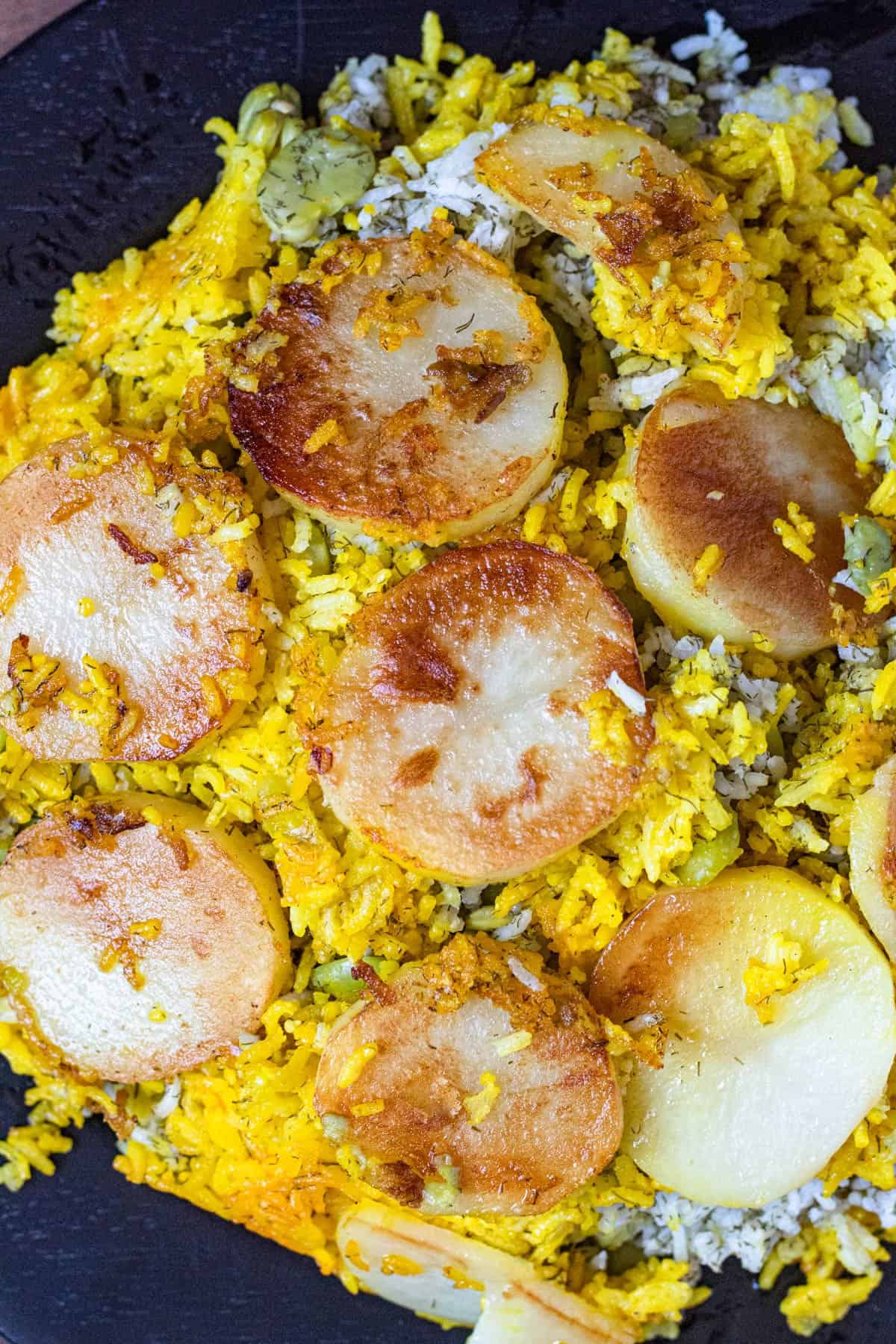
Hello Reader! I try my hardest to research recipes as best as I can before posting to ensure I am representing each culture correctly. If this recipe is from your country and I have made a mistake or you have suggestions for how to make it more authentic, I would love to hear! Please leave a comment below letting me know what should be different, and I will rework the recipe. It is always my intention to pay homage and respect to each cultural dish that I cook. Thanks for reading!
Baghali Polo, or Persian dill rice as it is sometimes called in America, is a popular item on Persian restaurant menus and for good reason.
It’s a flavorful but filling rice recipe that smells delicious and adds a beautiful pop of color to a plate as well. Fava beans are light and buttery and meld perfectly with the flavor of dill and steamed rice. Layers of crispy potatoes, rice and dill make each bite enjoyable.
Rice is a staple in Iranian and Persian cuisine. This fluffy rice dish can be paired with everything from meats and stews to sweet dried fruits. It is a favorite with lamb. You can enjoy an aromatic beef stew called Ghormeh Sabzi, also enjoyed in Iran, over a plate of basmati rice too.
Recipe Origins
“Baghali” is Farsi for fava beans, while “Polo” means pilaf or rice.
In Iran, fresh fava beans are sold in Iranian markets for only a few weeks in late spring. To eat they must be removed from their pod and separated from their outer skin. It’s a time consuming job but if you find these beans in a frozen package it’s likely already been done for you.
The bottom of this dish is called a tahdig, which is a Persian word meaning “bottom of the pot.” Potatoes and rice meld together to create a crispy crust that is considered the best part of the dish.
Why Make this Recipe
- Spice Up your Rice. Persian dishes are all about aromas, colors and flavors. Why settle for plain basmati rice when you can add so much flavor with the dill and color with the saffron and lima beans?
- Excellent Side Dish: This dish is traditionally served with lamb. You could substitute chicken or any other meat.
- “Travel” to Iran: This dish has all the fresh herb flavor that Persian food is known for. If you want to bring a bit of Iran to your table, including rice is a must.
Ingredients
Here is a visual overview of the ingredients in the recipe. Scroll down to the recipe at the bottom for quantities.
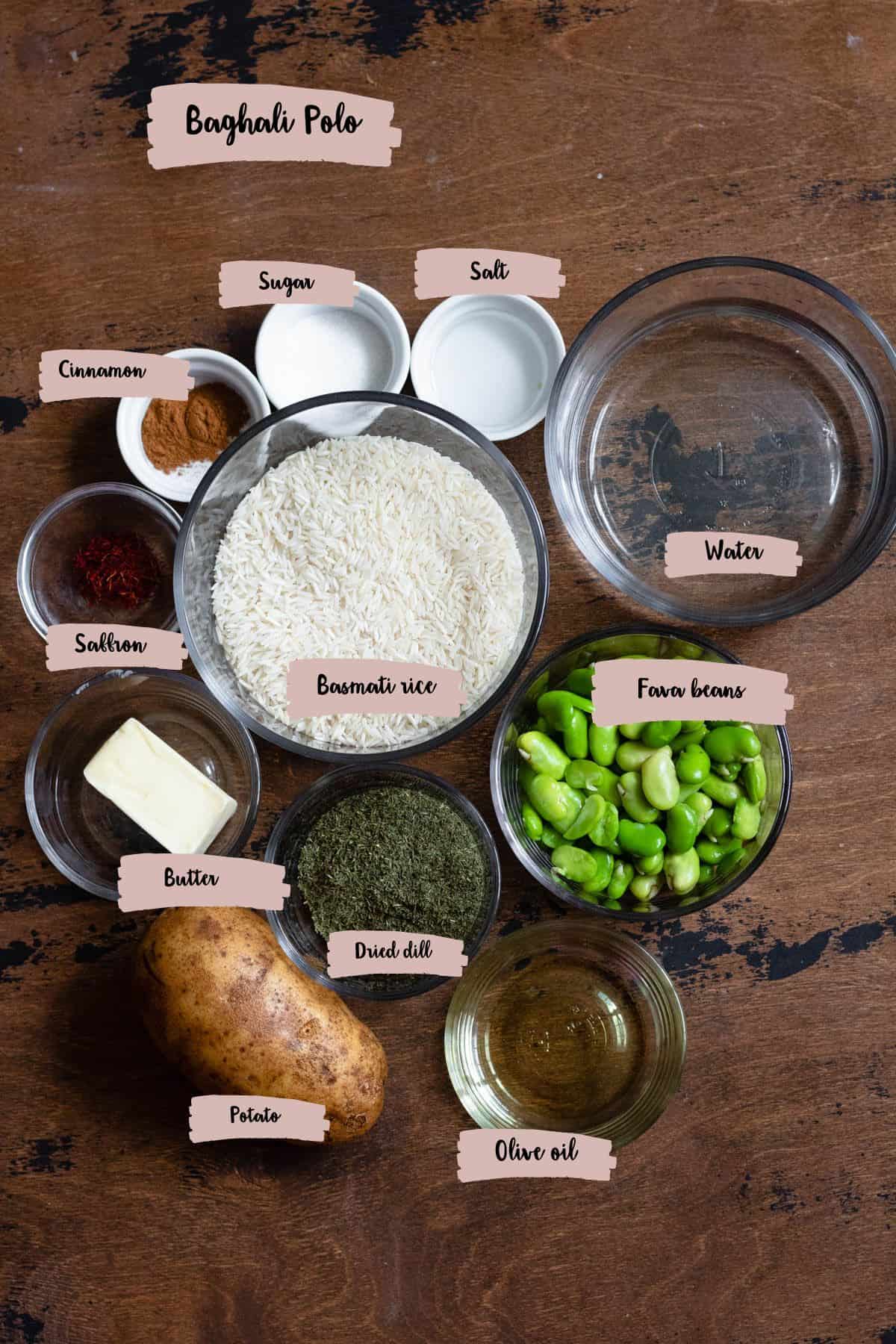
- Basmati Rice: Basmati rice is filling and not sticky like sushi rice. It’s fluffy with a very light flavor that allows it to soak up the flavor of added herbs.
- Dill: Dill, or shevid, is full of nutrients and antioxidants and has a flavor that is what makes this dish special. You can use fresh dill weed or dried dill for this recipe. If you’re using fresh chopped dill, try to remove as much liquid as possible and let the herb dry overnight before cutting. While fresh ingredients are always nice, dried dill won’t clump in your rice.
- Fava Beans: You can use fresh, frozen or dried beans. If you use fresh beans, be sure and keep an eye on them while cooking. Fresh beans become soft very quickly. If you have trouble finding fava beans you could substitute baby lima beans.
- Potatoes: The potatoes at the bottom of the pot cook in oil and form a crispy crust for the dish called tahdig. Some recipes leave the potatoes out but I feel like they add the perfect amount of crunch.
Tools
- Cooking pot. A nonstick pot works best for this recipe to achieve the perfect crisp at the bottom of the pan. Make sure and select one with a tight-fitting lid. What’s great about this recipe is you only need one pan.
- Stove top. Allow the rice to steam slowly on your stove top. No need to heat up the oven.
How to Make this Recipe
[adthrive-in-post-video-player video-id=”KathDYy0″ upload-date=”2022-08-03T15:23:35.000Z” name=”Baghali Polo” description=”Baghali Polo is a flavorful Iranian rice dish that combines the fresh taste of dill with basmati rice, saffron and fava beans. ” player-type=”default” override-embed=”default”]
Step 1: Prepare your Saffron Water
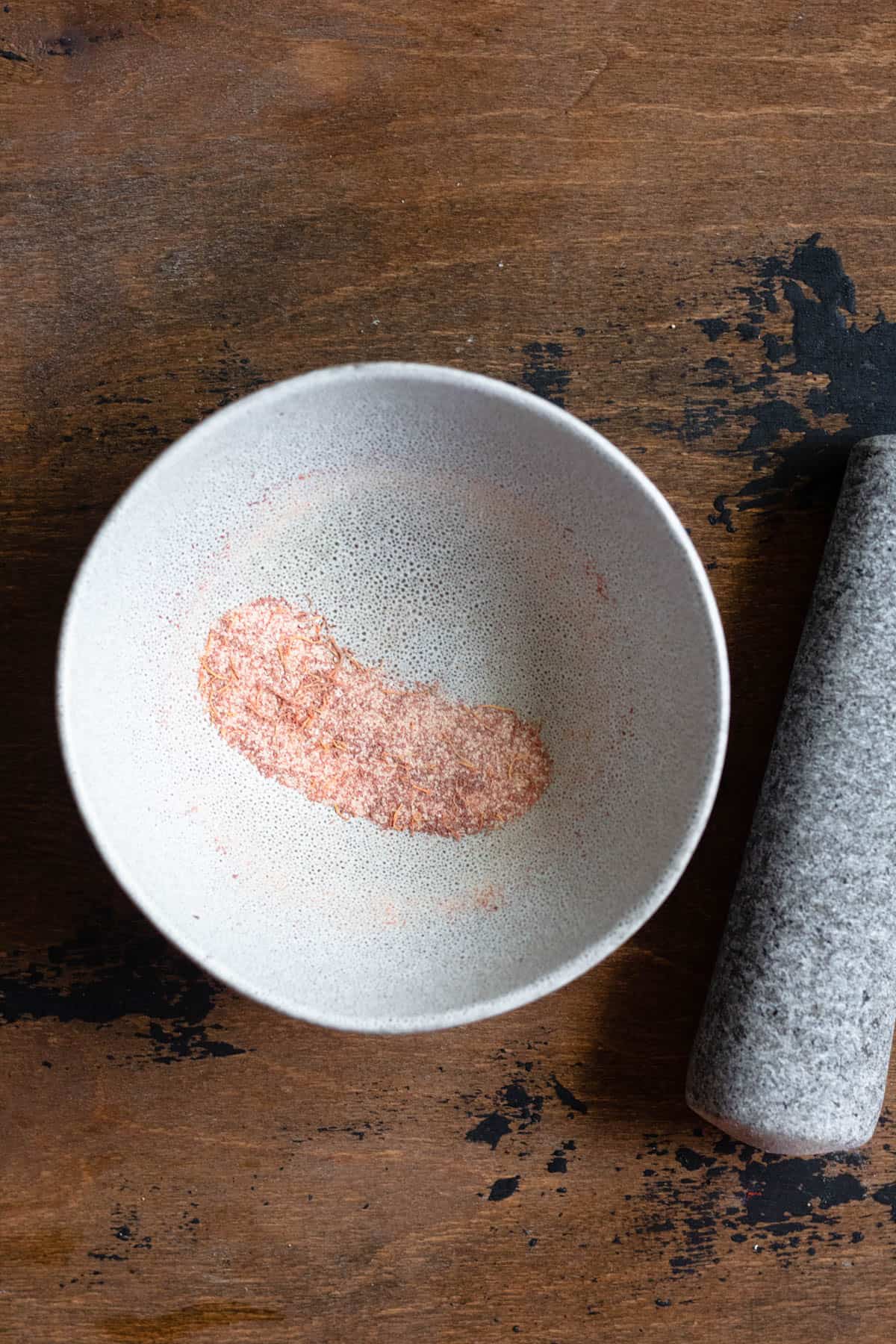
Use a mortar and pestle to grind the saffron threads down into pieces. Pour in the sugar and grind again until a fine powder is formed.
Move the mixture into a glass (or heat safe) jar. Add ¼ cup of boiling water into the jar.
Mix to combine and allow the saffron mixture to steep for at least 5 minutes. Set aside until you are ready to use it.
Step 2: Prepare your Rice
Place rice in a large bowl of cold water and cover with water.
Allow to soak for up to 3 hours, but at a minimum 30 minutes. Then pour rice into a colander to remove excess water.
Step 3: Cook the Fava Beans & Rice
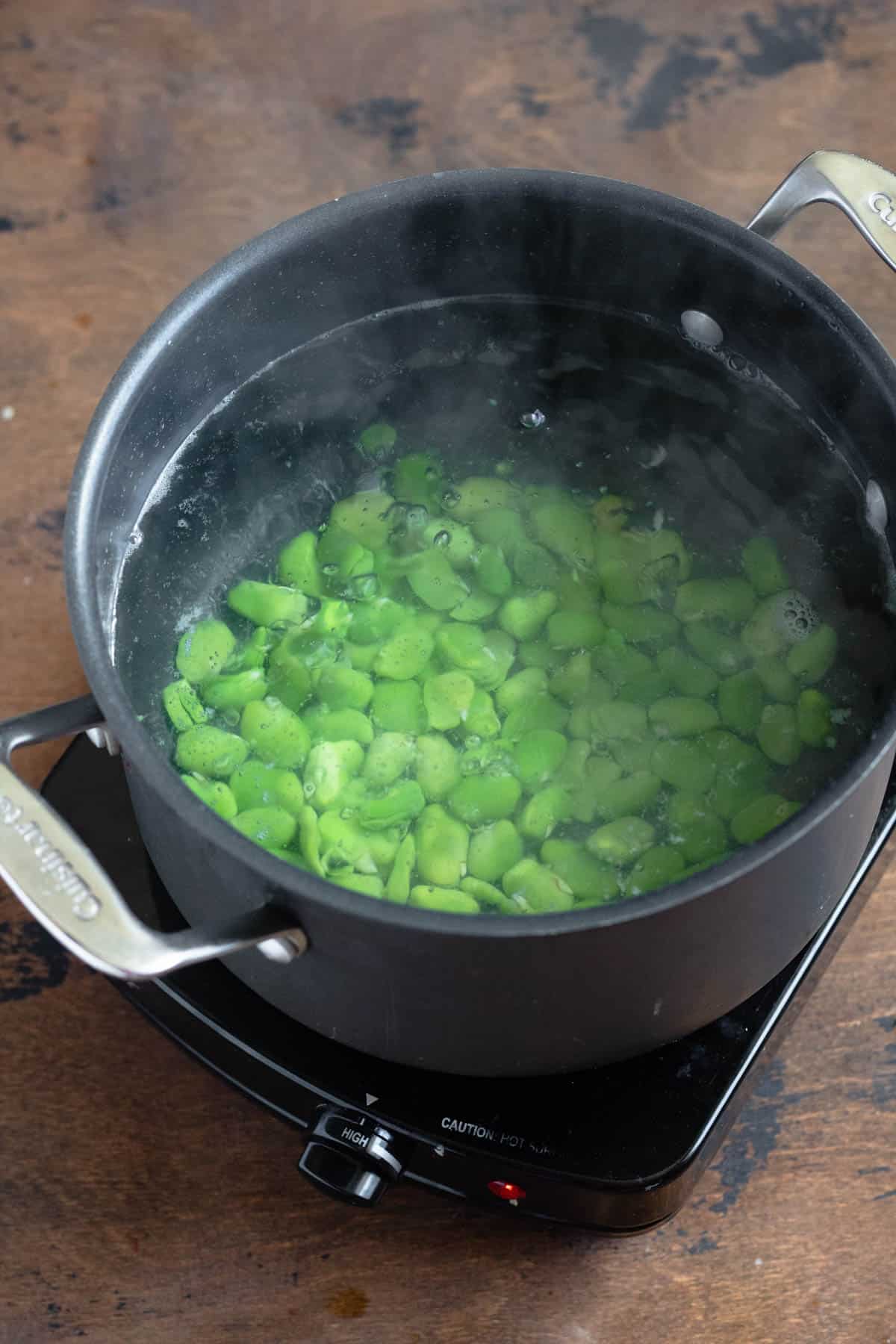
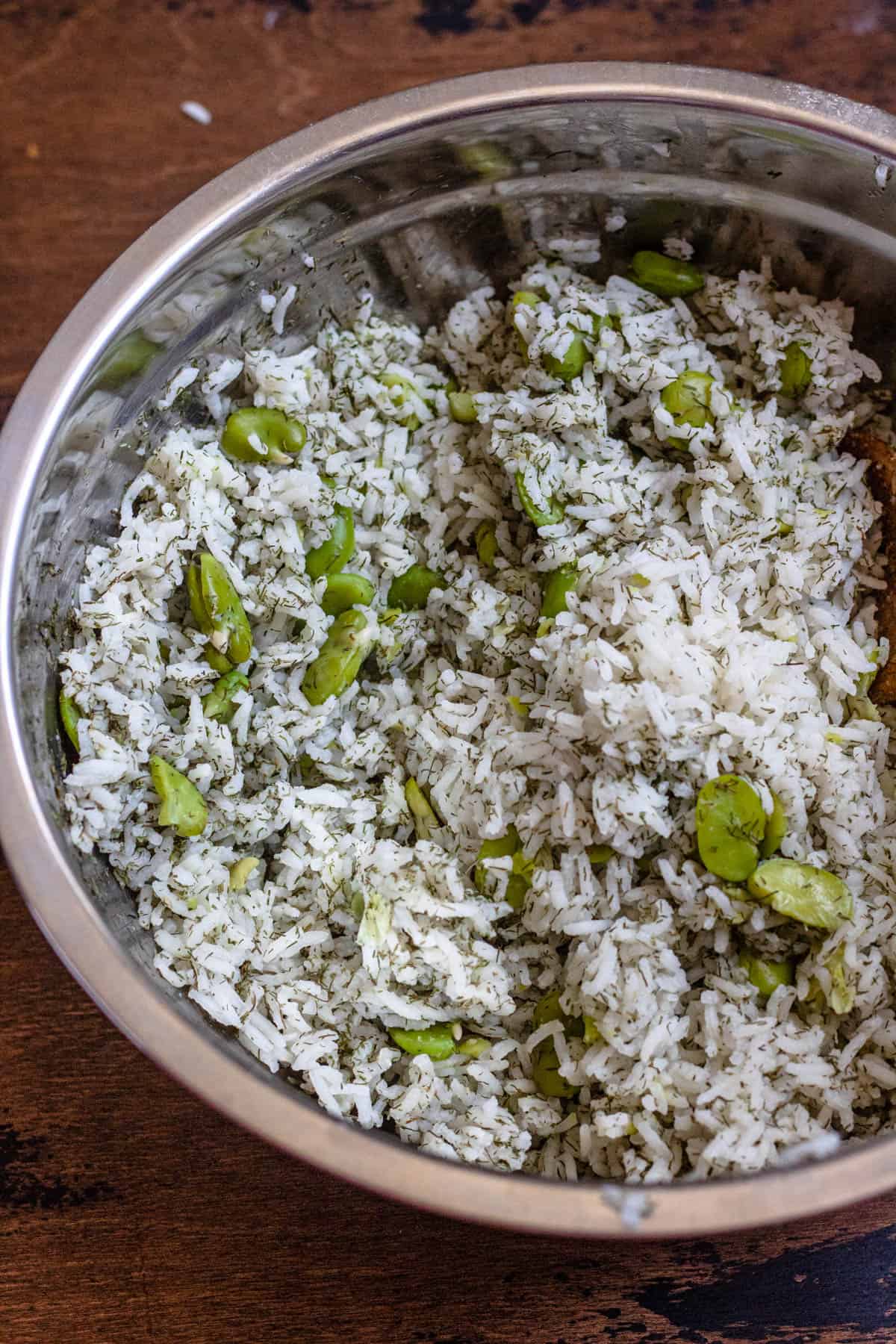
Salt a large pot of about three cups of water and bring it to a boil over medium heat.
Once boiling, add the peeled fava beans. Cook for 2 minutes and then add the soaked rice into the pot along with 2 tablespoons of dried dill.
Reduce the heat to a simmer. Cook uncovered for about 7-10 minutes, or until the rice is almost cooked all the way.
Remove about ½ cup of the cooked rice and rinse in a colander. Add 3 tablespoons of saffron water into the reserved rice and mix to fully combine.
Add the remaining dill into the unreserved rice still in the pot and stir to combine.
Step 4: Steam the Rice
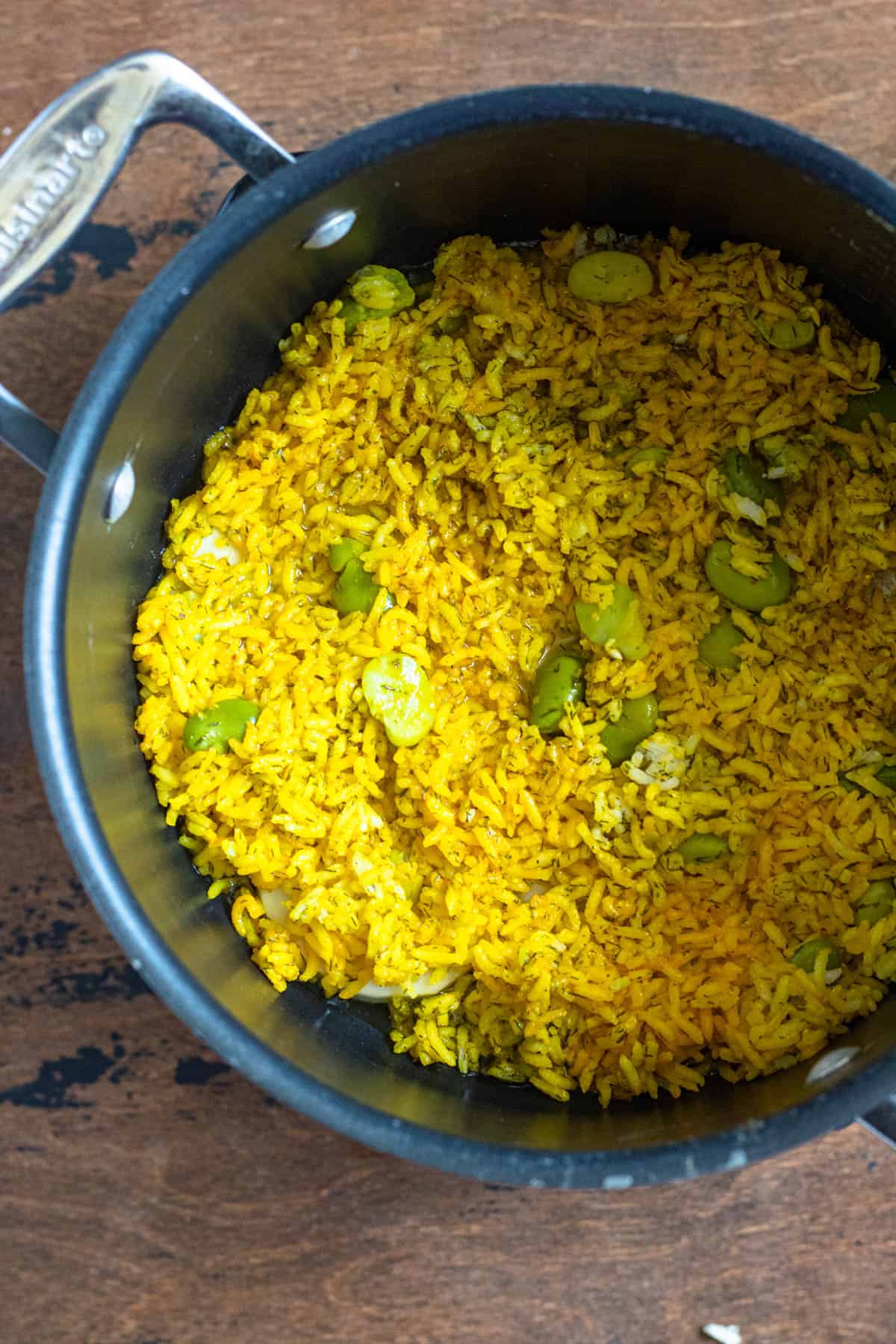
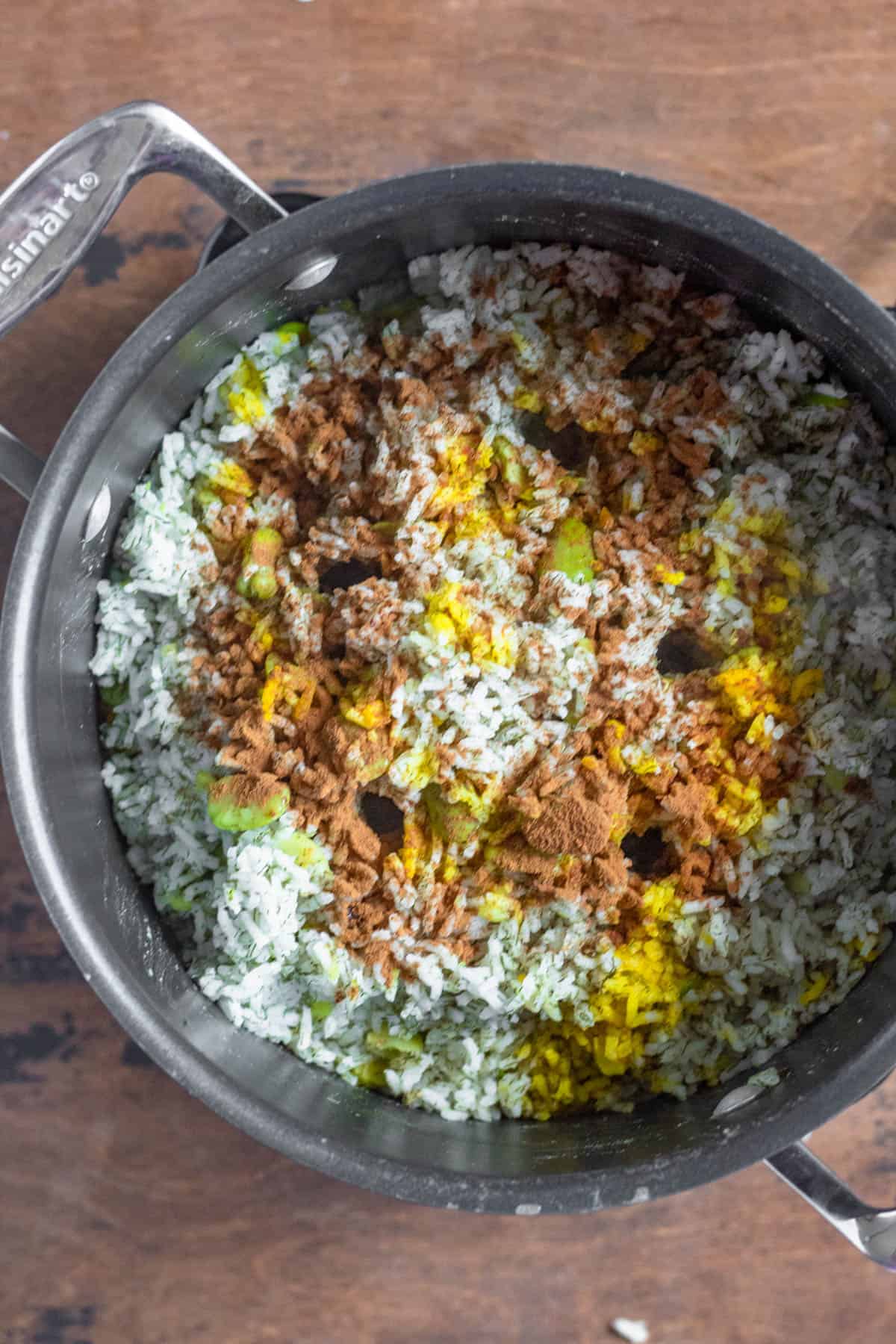
Peel the potatoes and cut them into thick slices.
Pour a thin layer of olive oil or vegetable oil into the bottom of your large pot. Add the sliced potatoes as the bottom layer, then place above it the reserved saffron rice as the next layer. Add the rest of the rice mixture on top.
Use the back of a spoon to poke holes in the rice, then drizzle ¼ cup of water over the top of the rice. You can also sprinkle with another 1-2 tablespoons of the saffron oil and add the cinnamon (optional) if desired.
Wrap the pot lid in a kitchen towel and place firmly on top of the pot. Allow to cook on low heat for another 40 minutes until the rice is tender and the potatoes are crispy.
When done, flip the contents of the pot onto a serving platter. Melt the butter and pour over the rice. Enjoy!
Expert Tips
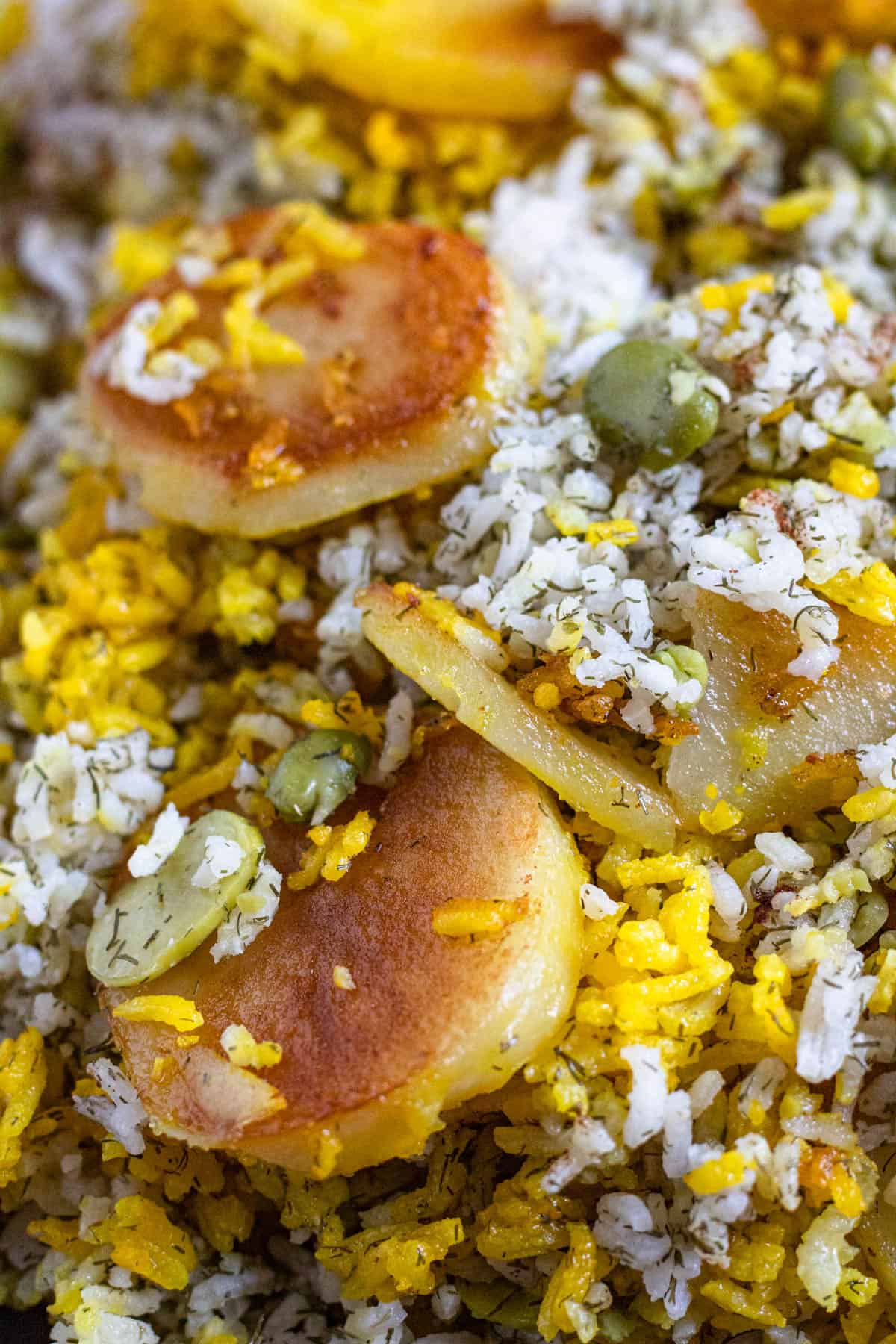
- Dried dill works best for sprinkling over the rice without it clumping. Some people prefer to use more dill for a stronger flavor. That’s up to you!
- Try not to overcook your rice. It should hold its shape and still have some white in the center. Between soaking, boiling and baking, the rice won’t be crunchy by the end, but you do not want it to be soggy.
- The cinnamon is optional but the combination of the cinnamon with the saffron and dill is really something special.
Recipe FAQs
Yes! If you’re unable to find fava beans you could substitute lima beans. You’ll probably have the best luck finding fava beans in the frozen section of your local Asian market.
Don’t leave the crispy tahdig in the pan! You can either flip the entire pan upside down, forcing the crispy potatoes to land on top or you can scoop out the rice into a serving dish and break the potatoes into pieces, arranging them along the edge of the dish.
Yes. Rice reheats very well. Your potatoes may not keep their crisp but the flavor will not go away. Store in an airtight container in the refrigerator for up to seven days.
Did you enjoy this Baghali Polo Recipe? If so, make sure to check out these other recipes I picked out just for you:
- Ghormeh Sabzi
- Vermicelli Rice
- Pigeon Peas and Rice from The Bahamas
- Muhammar Sweet Rice from Bahrain

Baghali Polo (Persian Dill and Fava Bean Rice)
Equipment
- Pot(s)
- Stove top
- Mortar and Pestle
- Platter
- Mixing Bowl(s)
Ingredients
- 1 tsp saffron
- ¼ tsp granulated sugar
- 1 ½ cups basmati rice
- 1 cup Fava Beans, peeled
- ¼ cup dried dill, or ½ cup fresh dill
- ¼ cup water
- ½ tsp ground cinnamon
- 2 tbsp olive oil
- 3 potatoes, sliced into rounds about ½” thick
- 4 tbsp butter
- salt, to taste
Instructions
To Make the Saffron Water
- Use a mortar and pestle to grind 1 tsp saffron down into pieces. Add ¼ tsp sugar and grind again until a fine powder is formed.
- Add the mixture into a glass (or heat safe) jar. Add ¼ cup of boiling water into the jar.
- Mix to combine, and allow the saffron to steep for at least 5 minutes. Set aside until you are ready to use it.
Baghali Polo Instructions
- Place 1 ½ cups dried Basmati rice in a large bowl and cover with water. Allow to soak for up to 3 hours, but at a minimum 30 minutes. Then pour off the water.
- Salt a large pot of water and bring it to a boil. Once boiling, add 1 cup peeled fava beans. Cook for 2 minutes.
- Add the soaked rice into the pot along with 2 tbsp of dried dill. Reduce the heat to a simmer. Cook for about 7-10 minutes, or until the rice is almost cooked all the way.
- Remove about ½ cup of the cooked rice and rinse. Add 3 tbsp of saffron water into the reserved rice and mix to fully combine.
- Add the remaining dill into the unreserved rice still in the pot and stir to combine.
- Peel three potatoes and cut them into thick slices.
- Add a thin layer of oil into the bottom of your large pot. Add the sliced potatoes as the bottom layer, then add the reserved saffron rice as the next layer. Add the remaining dill rice.
- Use the back of a spoon to poke holes in the rice, then drizzle ¼ cup of water over the top. You can also sprinkle with another 1-2 tbsp of the saffron oil and add the ½ tsp cinnamon (optional) if desired.
- Wrap the lid in a kitchen towel and place firmly on top of the pot. Allow to cook on low heat for another 40 minutes
- When done, flip the contents of the pot onto a serving platter. Melt 4 tbsp butter and pour over the rice. Enjoy!
Notes
- Basmati Rice: Basmati rice is filling and not sticky like sushi rice. It’s fluffy with a very light flavor that allows it to soak up the flavor of added herbs.
- Dill: Dill, or shevid, is full of nutrients and antioxidants and has a flavor that is what makes this dish special. You can use fresh dill weed or dried dill for this recipe. If you’re using fresh chopped dill, try to remove as much liquid as possible and let the herb dry overnight before cutting. While fresh ingredients are always nice, dried dill won’t clump in your rice.
- Fava Beans: You can use fresh, frozen or dried beans. If you use fresh beans, be sure and keep an eye on them while cooking. Fresh beans become soft very quickly. If you have trouble finding fava beans you could substitute baby lima beans.
- Potatoes: The potatoes at the bottom of the pot cook in oil and form a crispy crust for the dish called tahdig. Some recipes leave the potatoes out but I feel like they add the perfect amount of crunch.
- Dried dill works best for sprinkling over the rice without it clumping. Some people prefer to use more dill for a stronger flavor. That’s up to you!
- Try not to overcook your rice. It should hold its shape and still have some white in the center. Between soaking, boiling and baking, the rice won’t be crunchy by the end, but you do not want it to be soggy.
- The cinnamon is optional but the combination of the cinnamon with the saffron and dill is really something special.



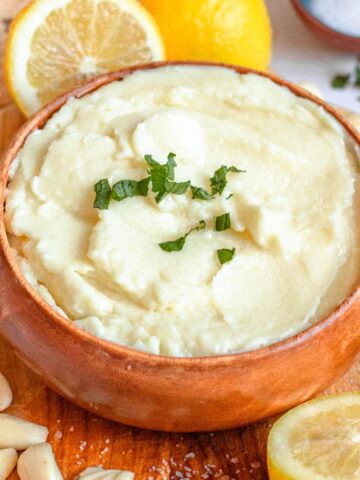
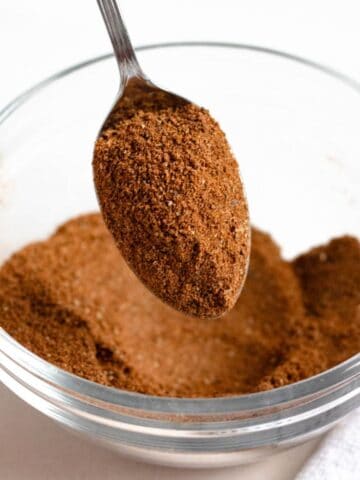
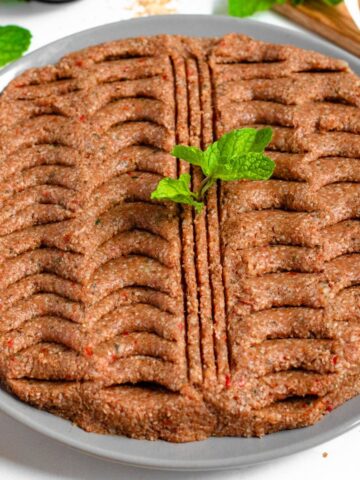
Cookery Magazine says
baghali polo is an amazing Persian food. never lose it.